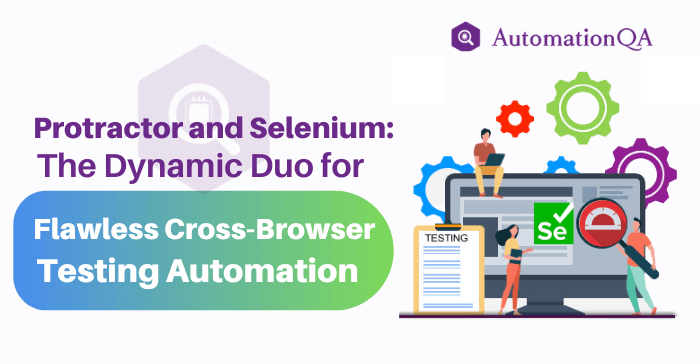
Are you tired of wrestling with cross-browser compatibility issues, constantly tweaking your code to achieve a seamless user experience? What if we told you there’s a powerful dynamic duo ready to revolutionize your testing process and make web perfection a breeze?
Say hello to Protractor and Selenium, an impressive pair that will transform your cross-browser testing automation. Imagine a world where tedious manual testing is a thing of the past, and you can confidently deploy your web applications with ease. Intrigued? Let’s unveil the secrets behind Protractor and Selenium, the ultimate testing tools for flawless cross-browser selenium automation testing.
The Basics of Cross-Browser Testing
Cross browser testing is a process to understand the feasibility, user experience, safety, and other features of web applications across different web browsers. With so many different web browsers available, testing your application across multiple platforms is essential to ensure a seamless user experience. There comes the role of Protractor & Selenium automation testing.
Now, let’s proceed to the next step.
Selenium- What Is It?
Selenium, an open-source tool, offers IDE, RC, Selenium Grid, and WebDriver for testing web applications on widely-used browsers like Mozilla Firefox, Internet Explorer, Google Chrome, and Safari.
Its compatibility with various languages, from Java to Python, Perl, .Net, Ruby, and C# makes it the best among other test automation tools. Icing on the cake, it is easily integrated with TestNG, Jenkins, Docker, Maven, and JUnit to use them best.
Automation Testing With Selenium-Benefits
- Multi-browser support
- Complete language and framework support
- Ease of implementation
- Open source availability
- Support across operations
- Reusability and integrations
- Option to quick changes to the code, reducing duplication, and minimizing complications
- Execute multiple tests in parallel and reduce the test execution time.
- Selenium demands less hardware compared to testing tools like QTP, UFT, SilkTest, and others.
- A wide range of documentation helps Selenium automation companies start testing easily.
Protractor- What Is It?
Protractor was initially owned by Google and later became open-source. It comes with the combined power of NodeJs, Jasmin, Cucumber, Mock, and Selenium WebDriver, making it a highly effective testing tool for web apps.
Protractor automation services are more like a wrapper around the most robust Selenium WebDriver API for employing native events and browser-specific drivers.
Automation Testing With Protractor – Benefits
- Performs end-to-end functional testing
- Identifies Web Elements with advanced HTML attributes
- Fast and easy testing
- Complete support for real devices
- Support to different languages for API bindings
- Availability of Asynchronous test execution
- Automatic waiting available
Are There Any Alternatives To Protractor And Selenium Automation Testing?
Like any other framework, these two have drawbacks forcing testers to look for alternatives. Be it a lack of reporting capabilities, or no support for native or mobile web, the de-facto tool Selenium is being challenged by these alternatives.
- Puppeteer
- Cypress
- WebdriverIO
- Playwright
- Cucumber
- TestCafe
- NightwatchJS
Protractor & Selenium – A Good Combo
- easily. Just use commands like by. model, by. repeater, by. binding or any other for that purpose.
- Protractor best uses Selenium Grid to initialize, control, and run browser instances.
- Integrating Jasmin, Mocha, and Cucumber framework becomes easy.
- Parallel testing support for multiple browsers
- Faster testing cycle as compared to other tools
- Angular-specific locator support.
Setting Up Your Environment For Selenium Testing
- Make use of protractor and selenium automation testing for multiple web browsers testing simultaneously, making the testing faster and more efficient.
- Install Visual Studio Code, Node.js, and npm
- Now, install the automation tools using the npm
- Configure the automation setup
- Specify the browsers, the URLs of your application, and other configuration settings.
- Writing your tests that simulate user interactions across different web browsers.
- Run your tests across different web browsers.
- Test everything from clicking on buttons, filling out forms, and navigating to different pages.
Protractor And Selenium Automation Testing Together – Is It Worth Trying?
Together, they provide a powerful solution for automating the testing of browsers. With Protractor, write tests quickly simulate user interactions in multiple ways, such as entering text, clicking on the button, or navigating to different pages. Selenium allows you to automate opening different web browsers and executing your Protractor tests.
Cross-browser testing is essential to ensure the functionality and compatibility of your web application. With these automation tools, you can automate the process of cross browser testing, making it faster and more efficient.
We understand sometimes you need a helping hand from top Selenium consulting partners. For that, reach out to our team.
AutomationQA
Latest posts by AutomationQA (see all)
- AI-Powered Self-Healing Test Automation for Mobile Apps - March 27, 2025
- How to Boost Your Cypress Testing with Component and Parallel Execution - March 21, 2025
- Migrating Test Suites to Modern Testing Frameworks: A Comprehensive Guide - March 18, 2025
